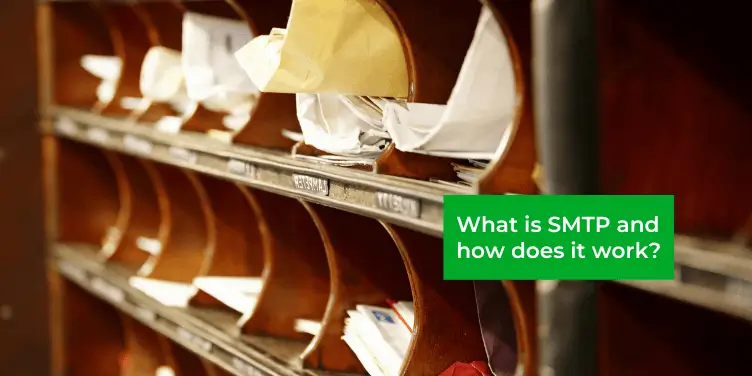You may have heard of the term SMTP when it comes to sending e-mail. And that's not surprising, because without SMTP, e-mailing would not be possible at all. But what exactly is SMTP? SMTP stands for Simple Mail Transfer Protocol.
SMTP is a protocol that allows your e-mail software to send e-mail and for that e-mail to arrive at the correct recipient. You can actually compare sending an e-mail to how you send a regular letter - if you still do that at all. We'll take you through the steps briefly, so you can compare it to how you send an e-mail.
The old-fashioned method
You write a letter and put it in the mailbox. The mailbox is emptied by the mailman, who takes the letter to the local sorting center. There they check where your letter should go and it is sent to the distribution center near the recipient. The recipient's mailman picks up the mail at the distribution center and delivers the letter to the recipient's home.
.webp?width=752&height=498&name=brievenbus%20(1).webp)
You don't see them much anymore, but they are still there; the old-fashioned mailbox.
The new-fashioned Method
When sending an e-mail, the whole process is very similar to how a letter is sent. SMTP ensures that an e-mail goes from your computer, through the appropriate servers, to the recipient. A server that (forwards) the mail is called an SMTP server.
But as long as you don't work in an IT department, you don't have to worry about exactly how this works. Because it all happens behind the scenes. Below, you can read about how SMTP more or less does its job.
How is an e-mail sent using SMTP?
- Mark wants to send an e-mail from his e-mail address mark@smartlockr.io to Judy at judy@mycompany.nl. After typing his message, he clicks send. Time for the SMTP mail server to spring into action.
- The e-mail is sent through a series of steps - which we won't bother you with now - to your own domain's SMTP server, in this case Smartlockr.io.
- That SMTP server looks at the recipient's domain - here Mycompany.nl - to see which domain the mail should be sent to.
- The sender's SMTP server contacts the SMTP server of Judy's domain, Mycompany.nl.
- Once they have confirmed each other's identity, the sending server connects to the recipient's server.
- The receiving server accepts and stores the message. Now the job is done for SMTP.
- Judy's e-mail program can retrieve Mark's mail from the server itself. This is always done by a protocol other than SMTP, namely POP3 or IMAP.
Every e-mail is sent using SMTP
SMTP is only about sending e-mail. Retrieving e-mail from the recipient's server is done by a different protocol. That can be POP3 or IMAP, depending on your company's settings.
.webp?width=752&height=376&name=postkantoor-postbussen%20(1).webp)
Just like in the post office, each letter is delivered to the right mailbox.
What happens if a mail cannot be delivered?
It can happen that the recipient's SMTP server cannot or will not accept an e-mail. This can happen, for example, because the recipient does not exist, or the mailbox is full. The e-mail is then returned to the recipient. When this happens, it is called a bounce.
SMTP is essential in daily e-mail traffic, as you now know. And it figures Smartlockr also works with SMTP. In fact, if an organization uses our SMTP Relay service, emails that need security are automatically encrypted. So then you can be sure that you are always applying the right form of security to all your email, whether you are bound by the GDPR or other regulations.
